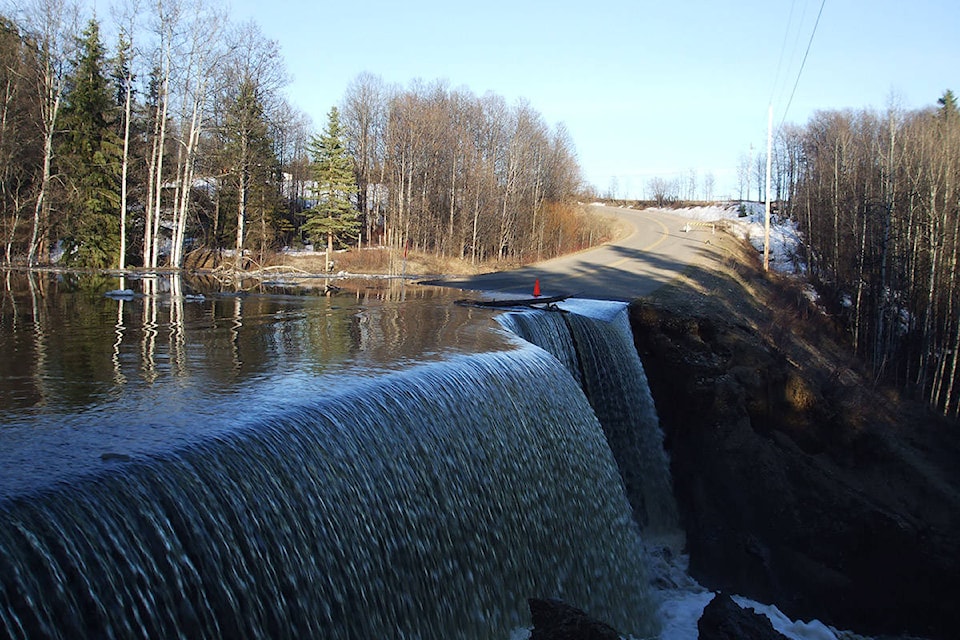Flooding conditions leading to washed out roads in the Lakes District have prompted questions about access to emergency services for residents living in remote areas.
The Lakes District News reached out to first responders — particularly on the Southside — to learn about how prepared they are in the event of serious flooding.
Floodwater has destroyed several sections of road following a rapid spring melt, notably the large wash-out near the 12 km mark of Ootsa Nadina Road, an incident that forced residents to use a logging road to access the Francois Lake ferry or to drive around the lake by way of Colleymount Road.
Ootsa Nadina Road reopened to single-lane traffic on May 18.
Firefighting capacity limited
Some risks come with the territory. For residents of the Southside, fire services for homes are provided by the Southside Volunteer Fire Department.
But residents living in certain areas, including households beyond the wash-out at the 12 km mark on Ootsa Nadina Road, live outside of the area served by the fire department.
The fire department has an obligation to taxpayers in their service area — and they can’t be in two places at once, said fire chief Evan Plesko.
As for reaching fire-afflicted homes using logging roads in case of a wash-out, he said their vehicles would be capable of handling the terrain.
But bigger challenges for the Southside fire crews include a lack of manpower and a shortage of funding for training and vehicles.
If widespread flooding occurred, the capacity of the fire department to respond would be limited, he said.
“In an evacuation situation, we’re the muscle and possibly the transportation, but that’s about it,” said Plesko.
Ambulances travel on “roads deemed safe”
Fatima Siddiqui, a communication officer for the BC Emergency Health Services (BCEHS), said that ambulance crews have been known to navigate logging roads.
She said that ambulances will take those secondary routes “as long as those roads have been deemed safe to travel by the corresponding authority, whether it be the Ministry of Transportation or municipal authorities.” Other examples include highway contractors, she said.
Siddiqui stressed the importance of patient safety, and said that ambulance crews are trained to take special precautions during floods.
If those roads aren’t available, alternate methods include air helicopters and fixed-wing aircraft. The BCEHS has dedicated air ambulances, but if they can’t get on-site fast enough, contracts are in place with local air carriers, she said.
She noted that there are ambulance stations at locations including Burns Lake, the Southside, Houston and Granisle, and that community paramedics can also respond to calls and perform emergency care.
Emergency plans for situations including floods are developed by Emergency Management BC in collaboration with local municipalities — the BCEHS is consulted in that process, but their job is primarily to carry out that plan “to the extent of providing patient care,” she said.
Police: “we’re prepared”
Corporal Greg Willcocks of the Burns Lake RCMP said that local police are prepared for a wide variety of calls in remote areas, allowing them to respond to incidents including boating accidents, drownings and lost hikers.
He stressed that the RCMP have access to a wide array of vehicles allowing them to access remote areas, saying the detachment is equipped with trucks, SUVs, boats and ATVs.
“We cover a very large area, as far down as Tweedsmuir Park,” he said, adding that the RCMP coordinates with the local Search and Rescue Association.
And if flooding led to a large-scale emergency, the RCMP would coordinate with Emergency Management BC to carry out an evacuation, he said.
“Hopefully that doesn’t come to pass, but if it does we’re prepared,” he said.
As for access to aircraft, he said that a number of helicopters are available to police in B.C. “We can always get some up here if we need some,” he said.
In one missing person case, the RCMP used a logging company’s helicopter, he said. “If worse comes to worse, we can always get charter helicopters.”
